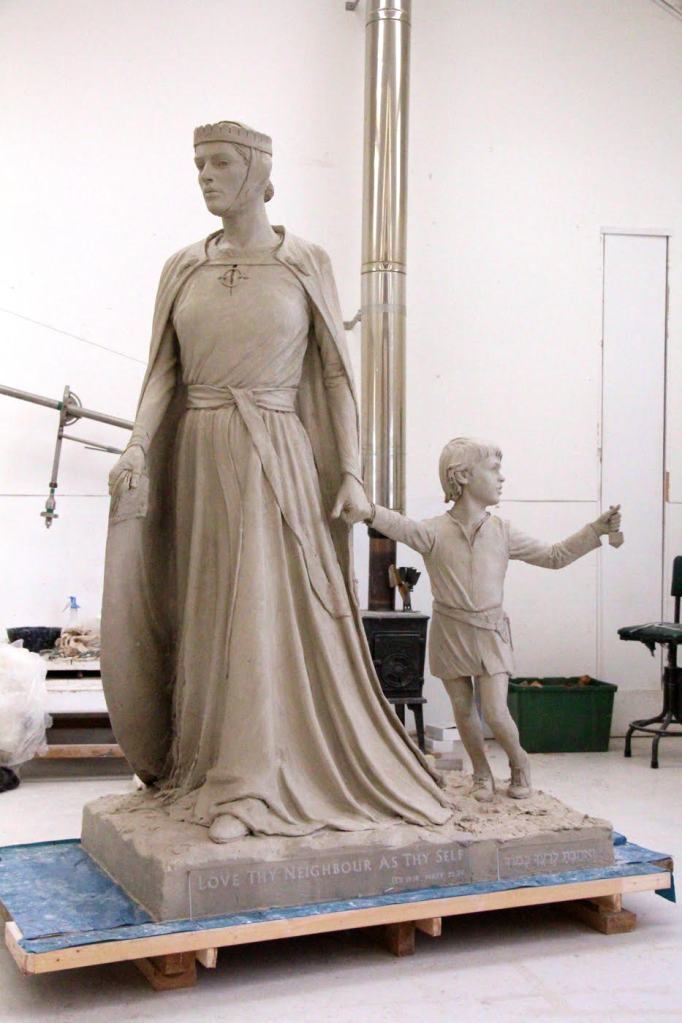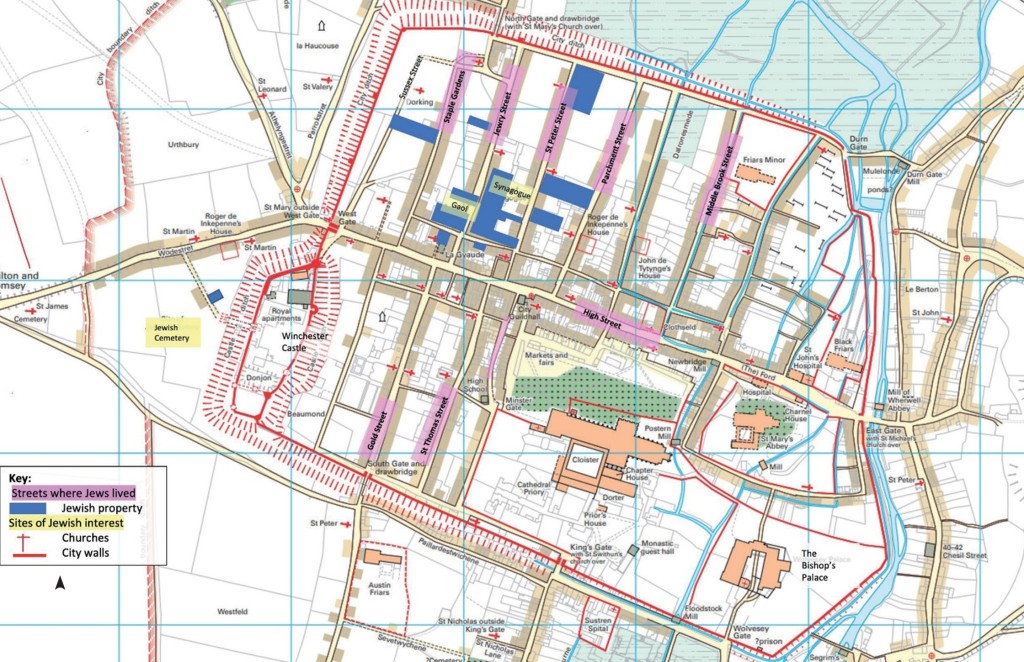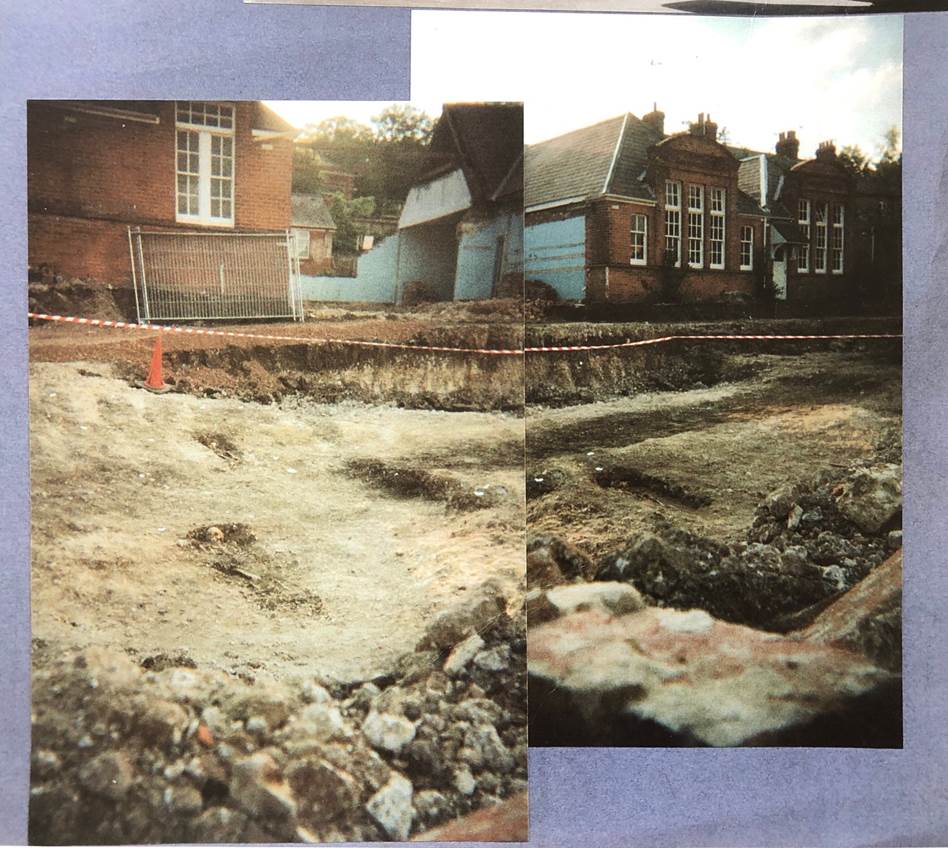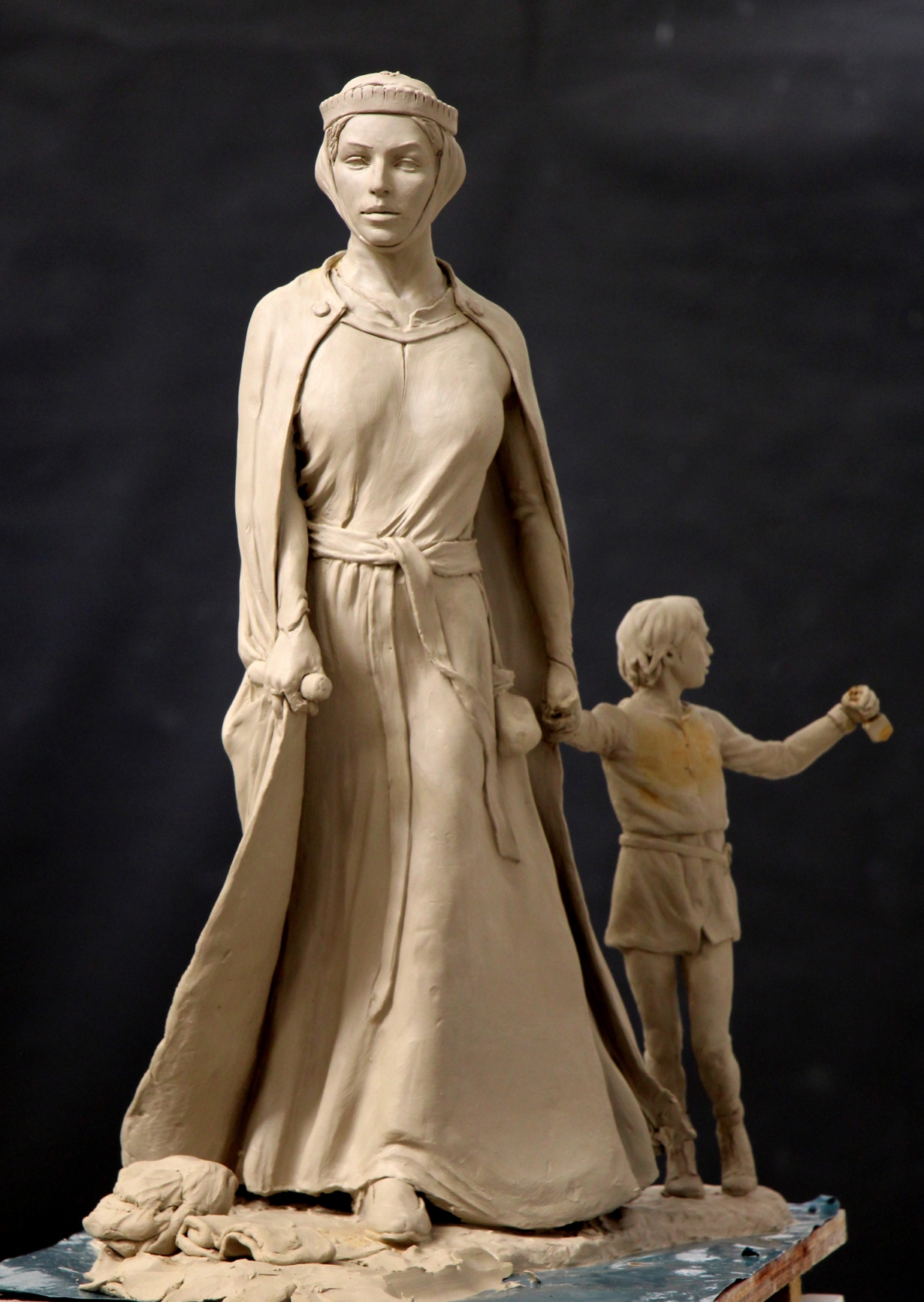


Significant progress has been made since our inception in 2017. The statue by Ian Rank-Broadley FRSS was unveiled in Winchester on 10 February 2022.
The Statue Project
Suzanne Bartlet was the first female Leader of Hampshire County Council and wrote the fascinating book ‘Licoricia of Winchester’ (Valentine Mitchell; London, Portland Oregon, 2009). In it she provides a compelling portrait of a lady who was eminent in her time, dealt frequently with Royalty, and whilst being a successful businesswoman in her own right, in her union with David of Oxford married one of the richest men in England. Her husband Leslie collaborated with her in her research and drew her attention to Licoricia.
There are many sites of Jewish interest in the City, which is not surprising given the significance and duration of the community in what was then one of the foremost cities in England. These include the Great Hall, where business transactions often took place, the castle, where the Archa containing records of loans was placed, the Cathedral, which contains medieval paintings of Jews, and Jewry Street, where the synagogue was located and Licoricia lived. A Jewish token was found during excavations in Brook Street, Winchester, which is in the care of the Winchester Excavations Committee.
It was a combination of realising how significant the medieval Jewish community were, and how little memory and evidence is left of the community today, that provided the genesis of the Charity.
The Charity was incorporated in August 2017, and Ian Rank-Broadley was commissioned to produce a maquette of Licoricia and her son Asser.
We are immensely excited by the prospect of highlighting Licoricia as a gateway to her forgotten medieval community, and by so doing linking to Winchester’s royal past, as well as promoting diversity and understanding, inspiring women and young people, and enhancing its busy location. Many thanks must go to Hampshire County Council for their help in offering the site for the sculpture and assistance to the Trustees.
Progress with the project
Dr Hannah Meyer delivered a fascinating talk on Licoricia and the Winchester Jewish Community to over eighty people at the Winchester Discovery Centre on Saturday 15 September 2018 as part of Winchester Open Days.
Since then we held a successful unveiling of the maquette in London, attended by many people including members of the Board of Deputies, and received the backing of both the Archbishop of Canterbury and the Chief Rabbi.
The statue was unveiled in early 2022 and we are now working hard on our educational work.
Winchester’s Historic Jewish Community
After Map 6, Winchester c. 1300, first published in the British Historic Towns Atlas Volume VI, Winchester © Historic Towns Trust and Winchester Excavations Committee 2017; not to be reproduced without written permission of copyright holders.
A historic map of Winchester is available from the Winchester Excavations Committee.


(The image above is of graves in the former medieval Jewish cemetery, taken by Marcus Collins when a building was demolished in Mews Lane in the 2000s).
A fascinating book is Derek Keene’s Survey of Medieval Winchester (Clarendon Press, Oxford 1985), which shows a map of the medieval Jewry in Winchester:
We are indebted to Suzanne Bartlet, author of the book, “Licoricia of Winchester” for the information set out below. Rebecca Abrams is writing our own book, which we hope to publish in early 2022.
The first evidence we have that Jews came over to England in significant number was following the Norman Conquest. They are reputed to have been invited to the country in order to encourage trade. They initially settled in London but by 1159 they had formed nine communities that were self-governing in Jewish matters, one of which was in Winchester. According to Suzanne Bartlet, most historians estimate that the Jewish population peaked at around 5,000 in 1200, compared to a population of around 4-5 million, although some consider this figure to be an underestimate.
The Jews were in a very precarious situation. Jews were to some extent restricted as to the trades they could carry out in this country (they were not allowed to own land for long enough to make it worthwhile for example) but they were in a wide range of trades, such as merchants in wine, wheat and wool; craftsmen in gold, silver and leather; musicians (popular in European Courts – please see https://www.iemj.org/fr/cours-conferences-et-musiques-en-ligne/musiques-juives-medievales.html); much sought after doctors and midwives; scribes and agents; and money lenders. The latter trade came about because certain forms of lending were regarded as a sin by the Church (this developed in the thirteenth century) and Christians were forbidden to engage in them by the Pope. Most credit did not pass through Jewish hands in medieval Europe, however, as the field contained many others including Italians, Christian military orders, Cistercians, and local merchants, moneychangers and bankers. Jews were however able to help provide funds for royalty, and for building castles, cathedrals and abbeys on an unprecedented scale. There were rules governing their lending activities such as a restriction on the amount of interest they could charge and how long they could hold land for once called in for unpaid debt.
The proportion of the Jewish population engaging in financial dealing is contested, especially given that many were informal or occasional moneylenders, like in the Christian community. Only a few families, probably 1%, were wealthy enough however to be top moneylenders.
The Jewish community provided an important source of private funds for the King and in return were granted his protection in his castles and other sanctuaries when they were threatened. The price for protection was substantial. They were regularly heavily and unpredictably taxed and the King took a proportion of their estate (generally a third but it could be as much as all of it) on death. In this way, they provided a private income for the King and his relatives. Winchester was important in this regard because in early medieval times the Royal mint and treasury was based there. King Henry III was born in Winchester Castle in 1207 and spent much time in the city. Jews providing finance to the king, including Licoricia, would conduct their meetings in Winchester’s Great Hall which still exists today.
It is not known when Licoricia, whose unusual name is associated with the term “sweetmeat”, was born but she first appears in Winchester in 1234 as a young widow, with three sons and a daughter by her first marriage*. By 1234 she had enough money and business acumen to be operating a money lending business in her own right. She is usually referred to as “Licoricia of Winchester” because Winchester was her main place of business. Jewish business women were not unusual and Winchester boasted a number of successful ones at the time. The education of Jewish women was encouraged and Licoricia would have been able to speak several languages (at least norman french, latin, vernacular english and, it is presumed, hebrew) and would have learnt her trade from her family and community. As records show, she was a formidable advocate. She settled in Jewry Street (then the main north-south thoroughfare) in a stone house on a large plot of land of around an acre on the west side of the street (opposite to where the statue will stand).
Many of Licoricia’s clients were landowners and minor gentry. Her first recorded loan was for a sum of £10 – this would be enough to pay for a new, fully fitted ship. Licoricia married David of Oxford, one of England’s richest Jews, in 1242 (please see the fascinating website on Jewish Oxford). Sadly, the marriage only lasted 2 years as David died in 1244, leaving Licoricia with her new son, Asser. As happened when a windfall to the Crown was expected, Licoricia was taken to the Tower of London whilst David’s estate was sorted out. In David’s case Licorcia paid the sum of 5,000 marks (£3,500) and Licoricia herself paid a further contribution of over £2,500 in inheritance tax. Most of the money went to pay for the building of Westminster Abbey and its rich shrine to Edward the Confessor. After David’s death Licoricia formed a close working relationship with Henry III and his Queen Eleanor and relatives. She became a leading figure in the community. Her business went well until the advent of the Barons’ Wars which had a severe detrimental effect on the Jewish community. One spring day, early in 1277 she was found murdered in her house in Jewry Street. As Licoricia was such a prominent Jew, her death attracted a lot of attention, the news even spreading to the continent. The motive for her murder is not known.
Less research has been conducted into the life of Licoricia’s son Asher. He appears to have acted as Licoricia’s agent on some transactions. The lives of the Jews were increasingly restricted and he had to move from one town to another as Jews were gradually expelled. It seems likely that he was finally forced to leave the country with the rest of the Jewish community in 1290.
There were many reasons why relationships with the Jews deteriorated in the latter half of the 13th century. First of all, they were taxed so heavily that they became less useful and there was mounting competition in money lending from abroad.
Secondly, they were unpopular with the barons and the increasingly meaningful parliament because they gave the King access to his own source of money.
Thirdly, they were accused of coin clipping and this caused a violent pogrom and many deaths. Although there is no evidence to suggest that Jews were engaged in coin clipping any more than their Christian neighbours, and in fact, as money lenders, it was not in their interests to do so, they were ten times more likely to be accused of it. Anthony Julius (Trials of the Diaspora, Oxford University Press, 2010, p116) writes ‘In the period 1278-9, while there were more Christian convicted defendants than Jewish ones (the ratio was about 5:4), ten times the number of Jewish men and women were executed than Christians. Across a longer period, the second half of the thirteenth century, Christian convicted defendants outnumbered Jewish ones by more than two to one, but the execution rate was about three Jews for every Christian. ….It appears that practically all heads of Jewish households were imprisoned for several months in the late 1270s on suspicion of having committed coinage offences. …In summary, during this brief period perhaps as many as half the country’s adult Jewish males were executed…the greatest massacre of Jews in English history.
Finally, they were unpopular with the Church, who made it increasingly difficult for Jews to survive by banning them from lending money at interest or, for example, from buying food from Christians. They also increasingly tried to convert them, and make them wear distinctive badges (also required for Moslems). As they could not farm, they risked starvation. In 1290 Parliament promised King Edward an enormous sum of money to get rid of them. He took the money and expelled the Jews. They were not allowed back into this country until the mid-seventeenth century when, inter alia, just as William the Conqueror had done, they were invited back in to increase trade.
Anglo-Jewry wrote poetry, and maintained close links with France, Germany and Spain. The following poem was composed by Meir of Norwich close to when the Jews of England were forced out of the country:
‘The land exhausts us by demanding payments, and the people’s disgust is heard
While we are silent and wait for the light.
You are mighty and full of light. You turn the darkness into light.
They make our yoke heavier, they are finishing us off.
They continually say of us, let us despoil them until the morning light.
You are mighty and full of light. You turn the darkness into light.
When he writes ‘You’ he is referring to G-d.
This was a sad end to the medieval Jewish community and perhaps because of this, its history has been buried for centuries. Small traces however still remain in Jewish tradition, such as the Passover song Ki Lo Na’eh (https://www.youtube.com/watch?v=G7tAJHt4zbI), first mentioned in the book Etz Chaim by Rabbi Jacob ben Judah of London in 1287, and still sung today
However, we live in a more open society nowadays and this offers us the opportunity to tell the story of Licoricia as a representative of the community of long ago, and give people a greater understanding of the rich history of the medieval Jewish community, its relationship with Winchester and its royal past and to understand the roots of some of the prejudices against Jews that began in the Medieval era and still exist today. This understanding, we hope, will help to fashion a greater understanding, tolerance and compassion towards the Jewish community and help to reduce all prejudice in our society.
*Asher means ‘happy’ or ‘fortunate’. He is introduced in Genesis 30:13, as a son of Jacob and Leah’s maid Zilpah. On learning of her pregnancy, “Leah declared, “what fortune” meaning “Women will deem me fortunate”. So she named him Asher.” In Genesis 49:20, Jacob prophesies “Asher’s bread shall be rich, and he shall yield to royal dainties”, and in Deuteronomy 33:24 Moses says “Most blessed of sons be Asher; may he be the favourite of his brothers, may he dip his foot in oil”.
More information is available in our new book, Licoricia of Winchester: Power and Prejudice in Medieval England, available online and in bookshops (in Winchester, P&G Wells, Tourist Information, ARC, City Museum and the Great Hall).
https://wordpress.com/page/licoricia.org/1375: History of the project and the time